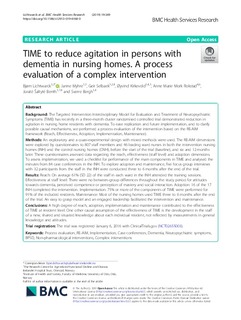| dc.contributor.author | Lichtwarck, Bjørn | |
| dc.contributor.author | Myhre, Janne | |
| dc.contributor.author | Selbæk, Geir | |
| dc.contributor.author | Kirkevold, Øyvind | |
| dc.contributor.author | Rokstad, Anne Marie Mork | |
| dc.contributor.author | Saltyte Benth, Jurate | |
| dc.contributor.author | Bergh, Sverre | |
| dc.date.accessioned | 2019-12-13T13:06:49Z | |
| dc.date.available | 2019-12-13T13:06:49Z | |
| dc.date.created | 2019-06-12T14:28:34Z | |
| dc.date.issued | 2019 | |
| dc.identifier.citation | BMC Health Services Research. 2019, 19 (1), . | nb_NO |
| dc.identifier.issn | 1472-6963 | |
| dc.identifier.uri | http://hdl.handle.net/11250/2633246 | |
| dc.description.abstract | BACKGROUND:
The Targeted Intervention Interdisciplinary Model for Evaluation and Treatment of Neuropsychiatric Symptoms (TIME) has recently in a three-month cluster randomised controlled trial demonstrated reduction in agitation in nursing home residents with dementia. To ease replication and future implementation, and to clarify possible causal mechanisms, we performed a process evaluation of the intervention based on the RE-AIM framework (Reach, Effectiveness, Adoption, Implementation, Maintenance).
METHODS:
An exploratory and a quasi-experimental design with mixed methods were used. The RE-AIM dimensions were explored by questionnaires to 807 staff members and 46 leading ward nurses in both the intervention nursing homes (INH) and the control nursing homes (CNH), before the start of the trial (baseline), and six and 12 months later. These questionnaires assessed data regarding the reach, effectiveness (staff level) and adoption dimensions. To assess implementation, we used a checklist for performance of the main components in TIME and analysed the minutes from 84 case conferences in the INH. To explore adoption and maintenance, five focus group interviews with 32 participants from the staff in the INH were conducted three to 6 months after the end of the trial.
RESULTS:
Reach: On average 61% (SD 22) of the staff in each ward in the INH attended the training sessions. Effectiveness at staff level: There were no between-group differences throughout the study period for attitudes towards dementia, perceived competence or perception of mastery and social interaction. Adoption: 16 of the 17 INH completed the intervention.
IMPLEMENTATION:
75% or more of the components of TIME were performed for 91% of the included residents. Maintenance: Most of the nursing homes used TIME three to 6 months after the end of the trial. An easy to grasp model and an engaged leadership facilitated the intervention and maintenance.
CONCLUSIONS:
A high degree of reach, adoption, implementation and maintenance contributed to the effectiveness of TIME at resident level. One other causal assumption of the effectiveness of TIME is the development in the staff of a new, shared and situated knowledge about each individual resident, not reflected by measurements in general knowledge and attitudes. | nb_NO |
| dc.description.sponsorship | The study is funded by a grant from the Innlandet Hospital Trust (Grant Number 150 333). The funding body did not take part in the design of the study, data collection, analysis, interpretation of data or in writing of the manuscript. | nb_NO |
| dc.language.iso | eng | nb_NO |
| dc.publisher | Springer Nature | nb_NO |
| dc.relation.uri | https://bmchealthservres.biomedcentral.com/track/pdf/10.1186/s12913-019-4168-0 | |
| dc.rights | Navngivelse 4.0 Internasjonal | * |
| dc.rights.uri | http://creativecommons.org/licenses/by/4.0/deed.no | * |
| dc.subject | BPSD; Case conferences; Complex interventions; Dementia; Implementation; Neuropsychiatric symptoms; Non-pharmacological interventions; Process evaluation; RE-AIM | nb_NO |
| dc.title | TIME to reduce agitation in persons with dementia in nursing homes. A process evaluation of a complex intervention | nb_NO |
| dc.type | Journal article | nb_NO |
| dc.type | Peer reviewed | nb_NO |
| dc.description.version | publishedVersion | nb_NO |
| dc.rights.holder | This article is distributed under the terms of the Creative Commons Attribution 4.0 International License (http://creativecommons.org/licenses/by/4.0/), which permits unrestricted use, distribution, and reproduction in any medium, provided you give appropriate credit to the original author(s) and the source, provide a link to the Creative Commons license, and indicate if changes were made. The Creative Commons Public Domain Dedication waiver (http://creativecommons.org/publicdomain/zero/1.0/) applies to the data made available in this article, unless otherwise stated. | nb_NO |
| dc.source.pagenumber | 16 | nb_NO |
| dc.source.volume | 19 | nb_NO |
| dc.source.journal | BMC Health Services Research | nb_NO |
| dc.source.issue | 1 | nb_NO |
| dc.identifier.doi | 10.1186/s12913-019-4168-0 | |
| dc.identifier.cristin | 1704389 | |
| cristin.unitcode | 1991,9,1,0 | |
| cristin.unitname | Avd Alderspsykiatri | |
| cristin.ispublished | true | |
| cristin.fulltext | original | |
| cristin.qualitycode | 2 | |

